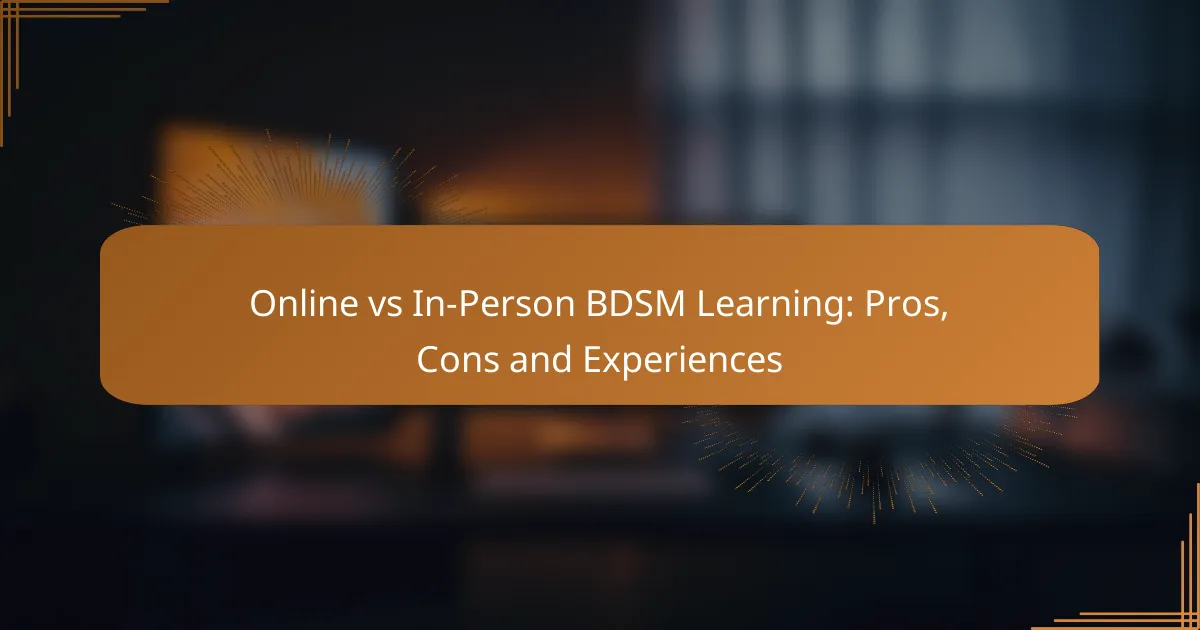Exploring [censured] can be approached through online or in-person learning, each offering distinct advantages and challenges. Online courses provide flexibility and a wider range of instructors, while in-person sessions foster direct interaction and hands-on experience. Understanding these differences can help individuals choose the best method for their personal learning style and goals.
![What are the pros of online [censured] learning?](/wp-content/uploads/what-are-the-pros-of-online-[censured]-learning-1.webp)
What are the pros of online [censured] learning?
Online [censured] learning offers several advantages, including flexibility, diverse instructor access, and cost savings. These benefits make it an appealing option for many individuals interested in exploring [censured] safely and conveniently.
Flexibility in scheduling
Online [censured] courses allow learners to choose when and how often they engage with the material. This flexibility is particularly beneficial for those with busy schedules or varying time commitments, as they can learn at their own pace without the constraints of fixed class times.
Many platforms offer recorded sessions, enabling students to revisit lessons as needed. This self-paced learning can enhance retention and understanding, making it easier to grasp complex concepts.
Access to diverse instructors
Online learning opens the door to a wide range of instructors from various backgrounds and expertise levels. This diversity allows learners to find teachers who resonate with their specific interests and learning styles.
Students can explore different techniques and philosophies, enriching their understanding of [censured]. This exposure can lead to a more well-rounded education compared to local in-person options, which may be limited in scope.
Comfort of learning at home
Learning [censured] online provides the comfort of a familiar environment, which can reduce anxiety and encourage open exploration. Students can engage with the material without the pressure of a physical classroom setting.
This comfort can foster a more relaxed atmosphere for asking questions and discussing sensitive topics, enhancing the overall learning experience.
Lower costs compared to in-person
Online [censured] courses often come at a lower price point than in-person classes, making them more accessible to a broader audience. Savings can come from reduced overhead costs for instructors, which can be passed on to students.
Additionally, learners save on travel expenses and time, making online options not only cheaper but also more convenient. Many platforms offer free resources or low-cost introductory courses, allowing individuals to explore [censured] without a significant financial commitment.
Anonymity and privacy
Online [censured] learning allows for a level of anonymity that in-person classes may not provide. Students can engage with content and instructors without revealing their identities, which can be crucial for those concerned about privacy.
This anonymity can encourage more honest discussions and exploration of personal interests, as learners may feel safer expressing themselves in a virtual setting. However, it’s essential to choose reputable platforms that prioritize user privacy and data security.
![What are the cons of online [censured] learning?](/wp-content/uploads/what-are-the-cons-of-online-[censured]-learning-2.webp)
What are the cons of online [censured] learning?
Online [censured] learning has several drawbacks, including the lack of practical experience, limited opportunities for community engagement, potential technical difficulties, and challenges in assessing instructor credibility. These factors can significantly impact the overall effectiveness of the learning experience.
Lack of hands-on experience
One major disadvantage of online [censured] learning is the absence of hands-on experience. Participants miss out on the tactile and physical aspects of [censured], which are crucial for understanding techniques and safety practices. For instance, learning how to properly use restraints or impact tools requires physical practice that cannot be replicated through a screen.
Without hands-on experience, learners may struggle to apply what they’ve learned in real-life scenarios. This gap can lead to misunderstandings about safety protocols or the dynamics of power exchange, which are essential in [censured] practices.
Limited community interaction
Online learning often lacks the vibrant community interaction found in in-person settings. Engaging with peers and instructors in real-time fosters a sense of belonging and support, which is vital for many practitioners. Online platforms may offer forums or chat rooms, but these often do not replicate the depth of connection formed during face-to-face interactions.
Networking opportunities are also diminished in online formats. In-person workshops allow for spontaneous discussions and relationship-building that can enhance learning and provide ongoing support in the [censured] community.
Technical issues during sessions
Technical difficulties can disrupt online [censured] learning sessions, leading to frustration and loss of valuable information. Issues such as poor internet connectivity, software glitches, or audio-visual problems can hinder communication and understanding. These interruptions can detract from the learning experience and make it challenging to follow along with demonstrations.
To mitigate these issues, participants should ensure they have a stable internet connection and familiarize themselves with the technology being used. Testing equipment before sessions can help minimize disruptions.
Difficulty in gauging instructor credibility
Assessing the credibility of online instructors can be challenging. Unlike in-person classes, where one can observe teaching styles and interact directly, online platforms may not provide sufficient information about an instructor’s qualifications or experience. This uncertainty can lead to concerns about the quality of education being received.
To address this, learners should research instructors before enrolling in courses. Checking for certifications, reviews from previous students, and engagement in the [censured] community can help ensure that the instructor is knowledgeable and trustworthy.
![What are the pros of in-person [censured] learning?](/wp-content/uploads/what-are-the-pros-of-in-person-[censured]-learning-3.webp)
What are the pros of in-person [censured] learning?
In-person [censured] learning offers several advantages, including direct interaction with instructors and peers, which can enhance the educational experience. Participants benefit from practical demonstrations and the ability to ask questions in real-time, leading to a deeper understanding of techniques and safety practices.
Hands-on practice opportunities
In-person [censured] classes provide valuable hands-on practice that online courses cannot replicate. Participants can physically engage with equipment, tools, and techniques under the supervision of experienced instructors. This direct experience allows learners to develop muscle memory and confidence in their skills.
For example, practicing knot tying or using impact toys in a controlled environment helps ensure safety and proper technique. This tactile learning is essential for mastering skills that require precision and sensitivity.
Immediate feedback from instructors
One of the key benefits of in-person [censured] learning is the ability to receive immediate feedback from instructors. This real-time guidance allows students to correct mistakes on the spot, enhancing their learning process. Instructors can observe body language and technique, providing tailored advice that online formats often lack.
For instance, if a participant struggles with a specific restraint technique, the instructor can offer direct assistance, ensuring that safety protocols are followed and skills are properly executed.
Stronger community connections
In-person [censured] learning fosters stronger community connections among participants. Engaging face-to-face allows for the development of trust and camaraderie, which can be crucial in the [censured] community. These connections can lead to lasting friendships and support networks.
Attending workshops or classes also provides opportunities to meet like-minded individuals, share experiences, and find potential partners for practice. Building these relationships can enhance one’s overall experience in [censured].
Enhanced sensory experiences
In-person [censured] learning offers enhanced sensory experiences that online learning cannot match. The physical presence of instructors and fellow participants creates an immersive environment where learners can fully engage their senses. This includes the feel of different materials, the sounds of equipment, and the atmosphere of the space.
For example, experiencing the weight and texture of various [censured] materials or the sound of a whip can significantly impact a learner’s understanding of [censured] dynamics. These sensory elements contribute to a more profound and memorable educational experience.
![What are the cons of in-person [censured] learning?](/wp-content/uploads/what-are-the-cons-of-in-person-[censured]-learning-4.webp)
What are the cons of in-person [censured] learning?
In-person [censured] learning can present several drawbacks, including higher costs, less scheduling flexibility, travel requirements, and potential discomfort in group settings. These factors can impact accessibility and the overall experience for participants.
Higher costs involved
In-person [censured] workshops often come with significant costs that can include class fees, materials, and venue expenses. Participants may also need to budget for additional costs such as food and accommodations, especially for multi-day events. This can make in-person learning less accessible for those on a tight budget.
For example, workshop fees can range from $50 to several hundred dollars, depending on the instructor’s expertise and the depth of the material covered. It’s essential to weigh these costs against the potential benefits of hands-on learning.
Less scheduling flexibility
In-person [censured] classes typically have fixed schedules, which can limit participants’ ability to attend. This rigidity can be challenging for those with busy lives or unpredictable work commitments. Unlike online courses that can be accessed at any time, in-person sessions require participants to be available at specific times.
To mitigate this issue, consider looking for workshops that offer multiple sessions or weekend options, allowing for greater flexibility in attendance.
Travel requirements
Attending in-person [censured] classes often necessitates travel, which can be a barrier for many. Participants may need to drive long distances or book flights, adding to the overall cost and time commitment. Additionally, travel can introduce logistical challenges, such as finding suitable accommodations.
To alleviate travel concerns, seek local workshops or events that minimize the need for extensive travel. This can help reduce costs and make participation more feasible.
Potential discomfort in group settings
Group settings in [censured] learning can sometimes lead to discomfort for participants, especially if they are new to the community or the subject matter. The dynamics of group interactions may create anxiety or inhibit open communication, which is crucial for effective learning.
To foster a more comfortable environment, look for workshops that emphasize inclusivity and provide opportunities for individual feedback. Smaller class sizes can also help create a more supportive atmosphere, allowing participants to engage more freely.
![How to choose between online and in-person [censured] learning?](/wp-content/uploads/how-to-choose-between-online-and-in-person-[censured]-learning-5.webp)
How to choose between online and in-person [censured] learning?
Choosing between online and in-person [censured] learning depends on your personal preferences, comfort level, and learning style. Consider factors such as accessibility, the quality of instruction, and the type of community you wish to engage with.
Pros of online [censured] learning
Online [censured] learning offers flexibility and convenience, allowing you to access courses from anywhere at any time. This format often includes a variety of multimedia resources, such as videos, forums, and interactive quizzes, which can enhance the learning experience.
Additionally, online platforms can provide anonymity, making it easier for newcomers to explore [censured] topics without feeling exposed. You can learn at your own pace, revisiting materials as needed to solidify your understanding.
Cons of online [censured] learning
One downside of online [censured] learning is the lack of hands-on experience, which is crucial for mastering practical skills. Without in-person guidance, it may be challenging to receive immediate feedback or address safety concerns effectively.
Moreover, online courses may lack the personal connection and community support found in in-person settings, which can be important for building trust and relationships in the [censured] community.
Pros of in-person [censured] learning
In-person [censured] learning provides direct interaction with instructors and peers, facilitating immediate feedback and hands-on practice. This format allows you to engage in real-time discussions and demonstrations, which can enhance your understanding of techniques and safety protocols.
Additionally, attending workshops or classes in person can foster a sense of community and support, helping you build relationships with others who share your interests. This social aspect can be invaluable for personal growth and confidence in [censured] practices.
Cons of in-person [censured] learning
In-person [censured] learning may require more time and financial investment, as you need to consider travel costs and class fees. Scheduling conflicts can also arise, limiting your ability to attend sessions regularly.
Furthermore, some individuals may feel uncomfortable or intimidated in a group setting, which could hinder their learning experience. It’s essential to assess your comfort level with in-person interactions before committing to this option.



